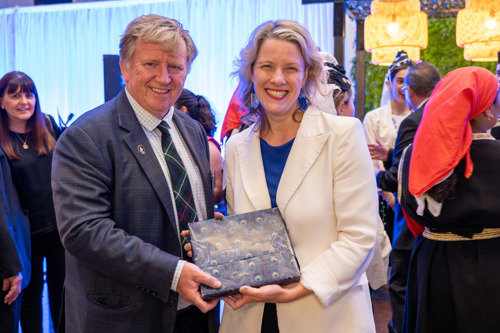Hotham local Jim Claven OAM received the Medal of the Order of Australia in the 2024 Australia Day Honours for his contribution to veteran services and community history – with a focus on the connection between Australia and Greece.
I spoke to Jim about his dedication to these veteran stories.
How did you become interested in history and, more specifically, specialise in war time narratives?
Since I was a young teenager, I’ve always been interested in history – an interest that was encouraged by my parents. I can still remember my father giving me a beautifully-illustrated volume about the Egyptian pharaoh Tutankhamen – quite a famous book as it turns out. I continued my history studies at Prahran High School and at Monash University, completing Bachelor and Master of Arts degrees.
My historical interests have ranged over many areas and topics, including labour and modern European history. But one of my loves has been classical civilisation and its history. The Centenary of Anzac in 2015 provided an opportunity for me to delve into both Greek and Australian history, through the story of Anzac. After many years in public service, I was working as a government relations consultant and agreed to prepare a submission on the Hellenic link to Anzac on behalf Melbourne’s Greek community. It was this work that brought me into this really interesting area of historical research.
For me, the most interesting aspect of this area is not so much the military aspects of the story themselves but rather the social history and personal stories to which war gives rise. War is a great disrupter to people’s lives and brings terrible destruction. But within this narrative, there are sometime poignant stories of the interaction of peoples, revealing our common humanity at such extreme moments in history.
The story of Lemnos or Imbros and their roles in Australia’s Anzac story contains many such narratives. The war brought together two peoples – the newly arriving soldiers and the local civilians – interacting and socialising, enjoying each other’s company and hospitality. These Islands and their people providing a welcome, if temporary, respite from the horrors of war on the nearby Gallipoli peninsula. A similar narrative can be found in the story of the Australians who served in the Greek campaign of 1941. It is these stories that I find so fascinating and compel me to continue my research.
What drives your passion and interest for preserving and sharing the stories of war, the Anzacs and our veterans?
As a historian, I am keenly aware of the fragility of memory and the historical record. With the passing of each generation, much of the history of today is lost. We must actively work to ensure that our lives and those around us are documented.
There is much concerning our Anzac history that has been preserved thanks to the active work of governments and the community. We see the evidence of this in the great archives held by the Australian War Memorial, the National Library of Australia and our own State Library of Victoria. These collections are vital to ensuring our history is preserved for the benefit of future generations.
As I have undertaken my research, I have become acutely aware that many important records remain outside these collections, in private collections, many in danger of being lost. There are some truly tragic stories of unique private collections being lost forever in house fires.
Through my work, many veterans’ families have approached me to help them in the donation process. It has been my pleasure to be able to help them donate their treasured family records – photographs and written documents – to the State Library. One of these was the photographic collection of a Victorian soldier who served in the Greek campaign of 1941, one Syd Grant. His collection contained some of the very few images of Australian soldiers on the run and evading capture by the enemy in Greece. Preserving such archives is essential if we and future generations are to be able to learn from the past.
One of Australia’s great success stories is how we have welcomed waves of migration which has built the Australia we know today. Spreading awareness of the stories of the Hellenic link to Anzac also provides a great opportunity to connect second and third generation Australians of Greek heritage with this almost unique combination of their Greek and Australian heritage. My good friend Lee Tarlamis OAM MP is the embodiment of this linkage. Lee’s father was born on the northern Aegean Island of Lemnos and one of his mother’s relatives was an Australian soldier from Blackburn who arrived on Lemnos with the Anzacs in 1915.
Delving deep into the social aspects of Australia’s Anzac story reveals this potential to create new connections across our diverse community stretching back into a common past. As a migrant myself – from Scotland – I am keenly aware of this opportunity to create community bridges through an appreciation of our common history.
What’s a little-known story or anecdote you have discovered in your research that would intrigue those in Hotham?
These conflicts brought Australians and Greeks together and created bonds in communities across Australia – and the community of Hotham is no different. I can point to two local stories that revealed to me how the Hellenic link to Anzac resonates in the history of the people of our own area.
One story relates to the family of Private William Withers, who by the end of the First World War were residing in William Street in Oakleigh. Originally from Ararat in Victoria’s Western District, William’s service file reveals that he had enlisted there in February 1915 and would serve with the 6th Brigade’s 22nd Battalion at Gallipoli. He sailed from Melbourne on 8 May 1915 aboard the appropriately named transport Ulysses, evoking the soldier-hero who fought at Troy recounted in Homer’s epic The Odyssey. After a period of continued training in Egypt, William and the Battalion departed Alexandria on 30 August, headed for Gallipoli aboard the transport Scotian.
As they sailed across the Aegean towards the Allied harbour at Mudros Bay on Lemnos, William and his comrades were sailing into danger. Around the same time, they were heading to Lemnos, another Allied troopship – the Southland – was torpedoed by an enemy submarine, resulting in major loss of life, some 40 Australians being killed or drowned, including the Australian 6th Brigade commander of the Colonel Richard Linton. The dead included two other Australians soldiers from Box Hill – the brothers Privates James and William Sloan of the 21st Battalion, also part of the 6th Brigade – both new arrivals with their family in Victoria from Glasgow in Scotland, where I was born and grew up.
Unlike the Southland, William’s transport arrived safely in to the vast protected harbour of Mudros Bay on Lemnos on 2 September. Here William would have his first experience of Greece and Greeks. This was the major advanced base for the whole Allied campaign at Gallipoli, its harbour full of shipping large and small and the surrounding shore and nearby hills full of Allied camps, store bases and medical facilities. As was the experience of many Australian soldiers arriving at Mudros Bay, he may have had his first interaction with the local Greek population as local fishermen sailed out to the troopships offering their fresh food and other wares for sale to the eager soldiers aboard the transports.
After a couple of days in the harbour William and the Battalion were transferred to another transport that took them to Anzac Cove and the trenches of the Gallipoli Peninsula, arriving there on 5 September. The trenches at Gallipoli were not only subject to enemy fire, they were also the sources of many of the diseases which plagued the troops there, killing many. And so it was that within a few days of his arrival at the front – on 11 September – William was admitted to the care of the 6th Australian Field Ambulance suffering from diphtheria. Soon he was transferred to the 1st Australian Stationary Hospital back at Mudros Bay, where William had only recently gazed on its shore and rolling hills a few days earlier. The staff of this hospital was overwhelmingly South Australian. Despite their care, William’s illness developed into pneumonia, and he died on 15 September. He was buried the next day at the East Mudros Military Cemetery located not far from the hospital. By 1920 his family back in Australia – now living in Oakleigh – would have received his three war medals and the distinctive memorial plaque, known as the dead man’s penny.
Another local connection is 21-year-old Oakleigh-born George Foot, a labourer from Notting Hill who enlisted at Dandenong in October 1939 for service with the 2/7th Battalion. Departing from Melbourne, George would arrive in the Middle East before departing for Greece in early 1941.
He took part in the disastrous Greek campaign as he and the other Allied forces faced the German invasion in April 1941. Advancing towards the front in northern Greece, George was part of the Allied defensive withdrawal, all under sustained air attack. Advancing as far as Larissa, the 2/7th Battalions retreat would end with its arrival at the embarkation port of Kalamata in the early hours of 26th April, most of the battalion was evacuated at 4am on 27th April, sailing in the troopship Costa Rica. But not George. He was one of the 8,000 Allied troops unable to be evacuated as the advancing Germans closed in on Kalamata, which they captured on 29th April.
What happened next is detailed in George’s own personal written account lodged in the military archives of the Australian War Memorial. Faced with surrender and capture, George was one of hundreds of Allied troops who opted to evade the Germans and hopefully find a way to return to Allied lines on Crete.
They headed west and along the Mani coast, with its mountains and small fishing villages, dreaming of escape. While George doesn’t mention the names of the various villages and locations he came to during his journey down the Mani coast, my research reveals that he would have travelled through many of the villages encountered by other Allied evaders, such as Trahila. He describes his journey along the coast, traversing ‘very rocky country’ with no boots and only a little clothing that the locals had given them, all the time under enemy air attack and German troops advancing behind them. It was ‘now very difficult travelling’ he writes. After one failed attempt to sail off the coast in a fishing boat, George made his way to an unnamed village where in the early hours of 1st May he became one of over 200 Allied soldiers taken aboard three Allied warships from these small coastal villages.
George survived the Greek campaign, returning to the Middle East, serving in New Guinea, reaching the rank of Lieutenant and returning to Australia, marrying and living in Mount Waverley. After the war, his Australian war medals would be added to with his award of the Greek Campaign medal by the Hellenic Government.
The lives of these two soldiers intimately connect Australia and Greece. They both had pivotal and life-changing experiences in Greece, one dying there. They both volunteered and embarked for war from Melbourne. They also served alongside those other Australian soldiers of Hellenic birth or heritage who also served in the Gallipoli and Greek campaigns, such as Private Peter Rados in 1915 and Gunner James Zampelis in 1941. Both had connections to our own local community and may well have and relatives that live in Melbourne today – maybe even nearby. Our city is home to Australia’s largest Greek-heritage community. The Hellenic link to Anzac unites these communities and has the potential to be the bridge for community awareness and understanding.



